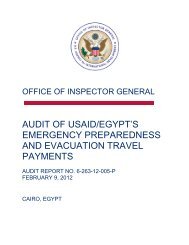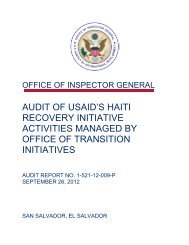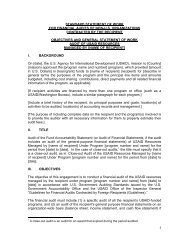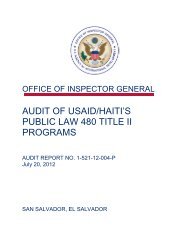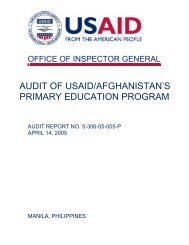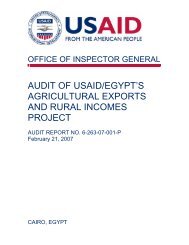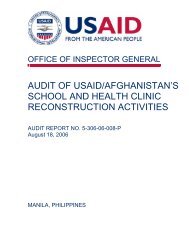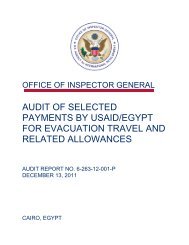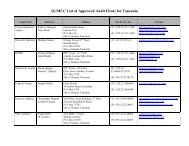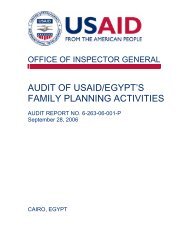USAID OIG Afghanistan and Pakistan Oversight Report, April-June ...
USAID OIG Afghanistan and Pakistan Oversight Report, April-June ...
USAID OIG Afghanistan and Pakistan Oversight Report, April-June ...
- No tags were found...
You also want an ePaper? Increase the reach of your titles
YUMPU automatically turns print PDFs into web optimized ePapers that Google loves.
Although <strong>USAID</strong> carried out numerous displaced persons programs in <strong>Pakistan</strong>, <strong>OIG</strong> found that monitoring<strong>and</strong> evaluation methods needed improvement. Specifically, <strong>USAID</strong>’s alternative monitoring methods—usedto monitor activities in dangerous <strong>and</strong> insecure areas, like FATA—needed to be strengthened. In addition,<strong>USAID</strong> had not implemented monitoring controls that were meant to provide reasonable assurance that $44million in cash-transfer funds had actually reached 140,000 displaced families as intended.<strong>USAID</strong>/<strong>Pakistan</strong>’s Capacity Building Program for the Federally Administered Tribal AreasDevelopment Program (<strong>Report</strong> No. 5-391-10-005-P, January 28, 2010)This audit pointed to several implementation difficulties in <strong>USAID</strong>’s capacity building programs in the FATAof <strong>Pakistan</strong>. The FATA region, which is the most economically depressed area of the country, has apopulation with a literacy rate estimated at only 17 percent, <strong>and</strong> 66 percent of people live below the nationalpoverty line.Local <strong>Pakistan</strong>i institutions responsible for overall governance, health care, education, <strong>and</strong> public worksprojects lack the capacity to manage services <strong>and</strong> development resources effectively. In an attempt toremedy this problem, in 2008 <strong>USAID</strong> awarded a 3-year, $46 million contract to Development AlternativesInc. to increase the capacity of these institutions.<strong>OIG</strong>’s audit found that, although the program had provided training, taken initial steps to automate FATAinstitutions, <strong>and</strong> completed some media activities, little had yet been achieved to build the capacity of FATAgovernmental institutions <strong>and</strong> NGOs responsible for providing services. The program had been in place fornearly 2 years of its 3-year planned lifespan, <strong>and</strong> it had not made significant progress with two of theprogram’s main goals: improving institutions’ capacity to govern, <strong>and</strong> improving the capacity of NGOs topromote good governance.Some of the problems could be attributed to the fact that the program had gotten off to a slow start. Duringthe first year, the contractor focused its resources on working out best approaches to designing <strong>and</strong>implementing activities, building up relationships with FATA institutions, <strong>and</strong> developing work plans. Also,the deteriorating security situation in Peshawar <strong>and</strong> the November 2008 assassination of the chief of partyof another <strong>USAID</strong> program delayed progress in the FATA capacity building program.Moreover, although the program had implemented a few activities to address FATA NGO weaknesses, thefew FATA-based NGOs that existed lacked the human <strong>and</strong> financial resources to promote good governanceeffectively. In most instances, FATA NGOs needed to strengthen their proposal preparation skills, financialmanagement practices, <strong>and</strong> monitoring <strong>and</strong> evaluation capabilities before they could start to promote goodgovernance.Because of a high-level change of emphasis in U.S. Government strategy toward greater involvement of<strong>Pakistan</strong>i organizations in implementing assistance programs, the mission began to rethink its strategy ofproviding the bulk of its program assistance through U.S.-based implementers such as DAI. As a result, in<strong>June</strong> 2009 the mission refrained from fully funding a DAI incremental funding request of $15.3 million <strong>and</strong>, 4months later, approved only $4.7 million in additional funds. In October 2009, the mission asked DAI toconsider preparing a 90-day demobilization plan. However, as of mid-November 2009, no final decision hadbeen made as to whether the DAI contract would undertake early demobilization <strong>and</strong> termination or, ifterminated, what program implementation mechanisms would replace the U.S.-based contractor.96 <strong>USAID</strong> <strong>OIG</strong> <strong>Afghanistan</strong> <strong>and</strong> <strong>Pakistan</strong> <strong>Oversight</strong> <strong>Report</strong>



